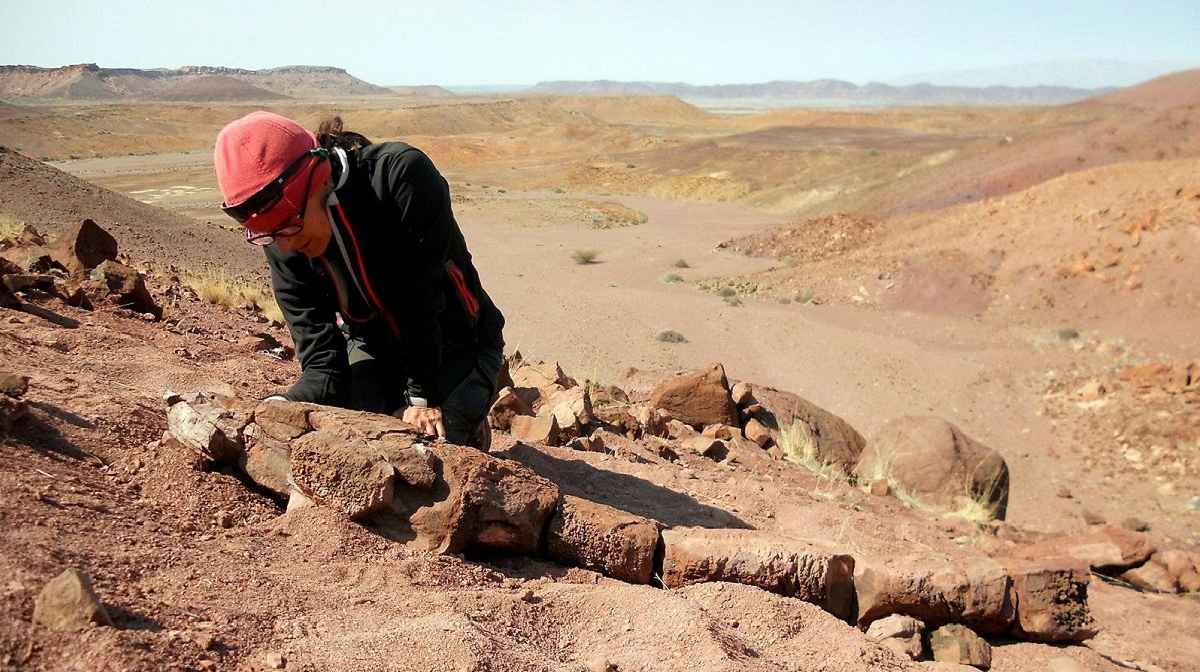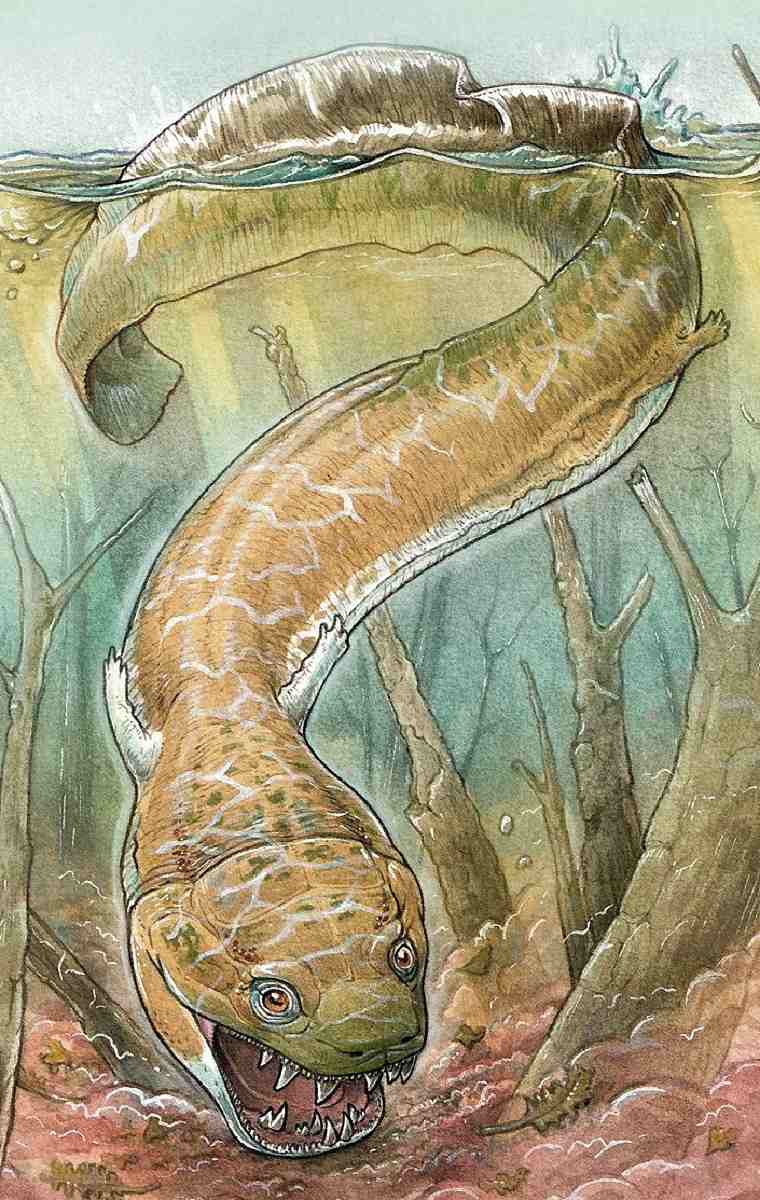
A scientist looks at the fossilized skeleton of the Permian Period salamander-like creature Gaiasia jennyae during fieldwork in Namibia in this undated handout photo obtained on July 3.
18:47 JST, July 19, 2024
You might call it the “swamp thing.” About 280 million years ago, a large creature built somewhat like a salamander but with frightful fangs prowled the swamps and lakes of what is now Namibia, ambushing prey as a top predator in a chilly ecosystem long before the dinosaurs.
The creature, named Gaiasia jennyae, lived during the Permian Period and measured at least 2.5 meters long — and perhaps up to 4 meters, according to researchers who announced the discovery of its fossilized remains. Its large, round, flat skull measured more than 60 centimeters long, and it had interlocking fangs at the front of its mouth.
“Wide flat heads in modern animals usually are used to generate strong suction to ambush prey by suddenly sucking it into their mouths. Gaiasia combines that with huge fangs for grabbing and killing large prey,” said Jason Pardo, a postdoctoral fellow in paleontology at the Field Museum in Chicago and one of the leaders of the research published earlier this month in the journal Nature.
The fossils were unearthed in Namibia, a country in southwest Africa. Because of the gradual movement over time of the crustal plates that form Earth’s outer layer — a process called plate tectonics — this place was even further south when Gaiasia lived, almost even with Antarctica’s current northernmost point. The bodies of water it inhabited may have sat alongside patches of ice and glaciers.
“In the far south, where Gaiasia lived, an ice age was ending, and it was still quite cold, with large glaciers at even low altitudes,” Pardo said.
Roughly 100 million years before Gaiasia existed, the first land vertebrates had evolved from fish with fleshy fins. These are called the stem tetrapods. They lived an amphibious lifestyle but were not true amphibians. The term tetrapod, meaning “four feet,” refers to all land vertebrates. The earliest ones, the stem tetrapods, spawned evolutionary lineages that led to true amphibians, reptiles and mammals.
While this was taking place, some stem tetrapods persisted, especially in remote places like Namibia was at the time. Gaiasia was one of these.
“Most of what we know of terrestrial life at this time comes from the ancient equator, preserved in rocks from Europe and North America. From that, we had thought early tetrapods were trapped in the tropics by their physiology,” Pardo said, until they disappeared amid competition from newly evolved competitors.
“Gaiasia shows clearly that this is not correct. Stem tetrapods were thriving at high latitudes in very cold environments, and those ecosystems were dominated by some very unexpectedly primitive animals. That forces us to rethink a lot about early tetrapod evolution,” Pardo said.
So Gaiasia was a stubborn holdover.
“Gaiasia is very different from anything else we’ve seen, so it could be a lone survivor, but it could also be part of a vibrant ecosystem of similarly strange animals that were no longer important parts of the ecosystem in the tropics,” Pardo said.
Evolution was moving in leaps and bounds during the Permian.

An artist’s rendering of the Permian Period salamander-like creature Gaiasia jennyae is seen in this image obtained on July 3.
“At this time, we see a flurry of evolution in the forerunners of mammals, such as Dimetrodon, an animal the size of a mountain lion that looked something like a big lizard with a giant sail on its back and was the top predator in most of these ecosystems. We also see forerunners of reptiles diversifying in interesting ways that mirror modern lizards, and the first true amphibians,” Pardo said.
The Permian ended about 252 million years ago with Earth’s worst mass extinction. The first dinosaurs appeared roughly 230 million years ago during the Triassic Period.
The creature’s name Gaiasia refers to the Gai-as rock formation in Namibia where it was found, and jennyae honors the late British paleontologist Jenny Clack, who studied early tetrapods. But how about a catchy nickname for it?
“‘Swamp thing’ is excellent,” Pardo said.
"Science & Nature" POPULAR ARTICLE
-

Genome Study Reveals Milestone in History of Cat Domestication
-

Big Leap in Quest to Get to Bottom of Climate Ice Mystery
-

Security Camera Footage Vulnerable to Outside Access; Investigation Finds 3,000 Pieces Exposed Online
-

Japan Set to Participate in EU’s R&D Framework, Aims to Boost Cooperation in Tech, Energy
-

Paws on Parade: Nairobi’s Dogs Dazzle at ‘Pawchella’
JN ACCESS RANKING
-

Tokyo Economic Security Forum to Hold Inaugural Meeting Amid Tense Global Environment
-

Keidanren Chairman Yoshinobu Tsutsui Visits Kashiwazaki-Kariwa Nuclear Power Plant; Inspects New Emergency Safety System
-

Imports of Rare Earths from China Facing Delays, May Be Caused by Deterioration of Japan-China Relations
-

University of Tokyo Professor Discusses Japanese Economic Security in Interview Ahead of Forum
-

Japan Pulls out of Vietnam Nuclear Project, Complicating Hanoi’s Power Plans























